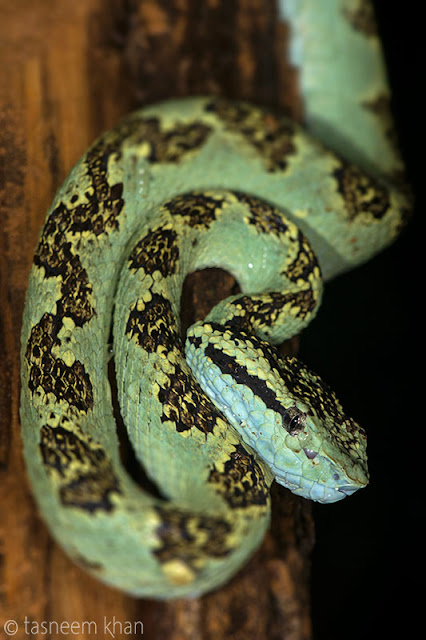Monsoon, the season of rain, takes on a whole
new meaning when you find yourself in the highest rainfall zone of the Western
Ghats – the second highest rainfall zone in India. Agumbe, a wonderfully
forested region in western Karnataka, often referred to by herpetologists as
the king cobra capital of the world, happens to be this region. It has been
known to receive an average of 7640 millimeters of rainfall a year and a record
of 4508 millimeters in a single month.
 |
|
The beginnings of a waterfall.
The intensity of this cascade will increase swiftly, sometimes in a matter of
hours, as the torrential rain beats down on Agumbe.
|
With 2 pelican cases full of camera
equipment, an underwater housing and dry bag, a few articles of clothing,
numerous ziplock bags, torches, UV lights, water proof ponchos, jackets and
tobacco (for the leeches!), we set out on our 7-day assignment. As one of
the finalist teams in the Saevus Trailblazers Of The Year competition, our designated
location was Agumbe. Our task was to tell a journalistic photo-story of
conservational relevance. The output required by Saevus magazine was a photo
essay of images and written content. Our personal goal, however, was to capture
the coming of the monsoon through images and video and create a short,
documentary-style film.
The uncertainty of what critters we might be
lucky enough to come by and, more importantly whether the arrival of the
unpredictable monsoon would coincide with our shoot played on our minds while
we traveled west from Bangalore city? We had a story to tell - Agumbe was our
set and home to our cast of characters.
The nature of Nature however, is such that
one needs to be patient to understand and document her stories. The
forest, the animals, the rain - they had no interest in our ambitious plans to
create a photo essay and short film in a span of 8 days - 7 days to shoot and
one day to edit. The days and nights that followed involved very little sleep
and merged into one long journey of exploration, focused attention to detail,
wonder and much learning.
What is not evident in the final film, of
course, is that it also involved multiple bites from numerous blood sucking
invertebrates - staying wet and cold for hours on end - the constant smell of
damp cloth - continuously cleaning the spray off our lenses - juggling,
cameras, umbrellas, tripods, while balancing on wet slippery rocks – laying
half submerged in streams waiting for the perfect moment – moments of
excitement and enlightenment, moments of extreme frustration and despair.
From a photographer's point of view, what
made this most challenging and most interesting for us was that our subjects,
for the most part, were what most people consider uncharismatic. Every
photograph was therefore carefully composed with the intention to achieve a
slightly different perspective. Extreme close-ups and wide angles helped
portray the subject’s life, habitat and connection to water.
With the coming of the monsoons and the first
few showers, one witnesses a miraculous transformation of the space - changes
that occurs in more ways than can be perceived by a casual observer. At first
the thirsty laterite soil seems to absorb every drop of water. But the rain is
incessant, and soon every little ditch, depression and trench is converted into
a water body. Dry streams, reduced to a series of interspersed pools and rocks
in the summer months, begin to trickle and then flow. Rivulets course through
plantations and forests, rapidly feeding these streams and rivers. As the
rivers begin to flow, cascading over weathered rock, fallen trees and the dry
banks, they set in motion countless processes of revival, birth, growth, life
and death.
Water and moisture have profound effects on
germination, breeding, nesting, spawning, metamorphosis, movement and feeding
of organisms across taxa. From bacteria to birds, snails to reptiles, frogs to
fish, arthropods to otters and everything in between, there is an evident burst
of activity. The system can be best described as an action flick or a living
laboratory.
Water makes up 97.5% of our planet, only 3.5%
of which is fresh water.
Freshwater ecosystems occupy only 0.8% of the
earth’s surface, but harbour nearly 6 % of all known species. These incredibly
dynamic and rich systems function as the backbone for life as we know it.
 |
|
In
the first few weeks of the monsoon this stream will be gushing with water and
all the aquatic vegetation visible here will be completely submerged.
|
Pundits the world over are already predicting
our future water woes. It is common opinion that the wars of the not so distant
future will be waged over water. This, however, continues to remain a very
anthropocentric perspective. There are millions of other species that inhabit
this planet alongside us. Agumbe shows us just a fraction of this diversity and
their dependence on the fresh water. Whether we choose the stance of stewards
of the planet, or simply fragments of the web of life, we are intrinsically
linked to this resource, system and all the life it supports. We have a
responsibility to conserve and utilize water wisely, and most importantly,
realize that it is an invaluable and limited resource.

 |
|
A
Malabar Pit Viper (Trimeresurus
malabaricus) sitting motionless in the rain.
|
 |
|
A
Hump-nosed Pit Viper (Hypnale hypnale).
VIEW OUR SHORT FILM ON THE AGUMBE MONSOONS: https://www.dropbox.com/s/2rt8botnmrpta3d/Agumbe%20Monsoon.m4v |





